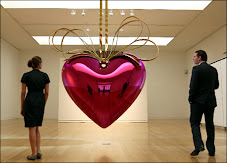oc·a·ri·na (ŏk'ə-rē'nə)
n. A small terra-cotta or plastic wind instrument with finger holes, a mouthpiece, and an elongated ovoid shape.
[Italian, from dialectal ucarenna, diminutive of Italian oca, goose (from the fact that its mouthpiece is shaped like a goose's beak), from Vulgar Latin *auca, from *avica, from Latin avis, bird; see awi- in Indo-European roots.]
Decorated with figures in ceremonial dress and various animal effigies, clay ocarinas were a standard part of ceremonial life in pre-Columbian Central America. Made with a varying number of tone holes and in different sizes, ocarinas could imitate the calls of small birds as well as the resonant hoots of owls. Photo by Roger Hamilton—IDB.
The object I chose to look at in more detail was a small Pre-Columbian ceramic whistle. This was made in Peru, and was made inland, though it is in the shape of a shell. It is about 2” / 3” wide, and it was burnished and slip decorated. Like other Pre-Columbian vessels, it is unglazed and probably pit-fired. The animist culture in which this was made had great respect for the natural world, and this is apparent in their vessels for ceremony as well as those for everyday use. Respect for the ocean, as a metaphor for life, as a great source of food and weather, is apparent in their decorations and choice of forms. These simple forms, mimicking seashells, have a peaceful feeling to them. I am not sure exactly what they were used for, but they are said to have precise tones, possibly for specific people, times of the year, or for specific ceremonies. These were surely made after people had made similar whistles out of real shells. The people further from the ocean probably had a harder time getting objects from the ocean, but this did not hinder their desire to have such objects, they just made them out of clay. They also made many other sea forms, of other shells, fish, shellfish, and mammals. It is not hard for me to imagine a culture that was connected to nature in a way that our culture is not. Pre-Columbus, and Pre-Christ humans were generally more connected to the earth and its other inhabitants. People also thought of things cyclically, as the seasons cycle through time, as apposed to a more linear view of the world that was created primarily through Christianity. There are contemporary equivalents to such objects, but I have never seen or heard of them being used ceremonially today. The Pre-Columbian objects are worth quite a lot today, as they are “artifacts” from a past culture. I would love to have a small Pre-Columbian object. I had an attraction to these wares/objects long before I began working with clay myself. The relationship to the human body is obvious, it was made to be picked up and blown through.
Subscribe to:
Post Comments (Atom)
.jpg)











No comments:
Post a Comment